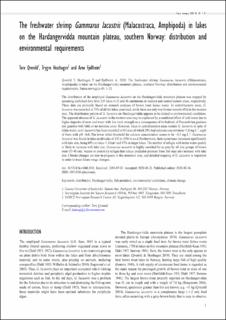The freshwater shrimp Gammarus lacustris (Malacostraca, Amphipoda) in lakes on the Hardangervidda mountain plateau, southern Norway: distribution and environmental requirements
Journal article
Published version

Åpne
Permanent lenke
https://hdl.handle.net/11250/2648112Utgivelsesdato
2020Metadata
Vis full innførselSamlinger
- Scientific publications [1392]
Originalversjon
10.5324/fn.v40i0.3101Sammendrag
Qvenild T, Hesthagen T and Fjellheim A. 2020. The freshwater shrimp Gammarus lacustris (Malacostraca,
Amphipoda) in lakes on the Hardangervidda mountain plateau, southern Norway: distribution and environmental requirements. Fauna norvegica 40: 1–21.
The distribution of the amphipod Gammarus lacustris on the Hardangervidda mountain plateau was mapped by screening published data from 245 lakes in 11 and 16 catchments in western and central/eastern areas, respectively.
These data are primarily based on stomach analyses of brown trout Salmo trutta. In central/eastern areas, G. lacustris was recorded in 79% of all the lakes examined, while there are only two former records (4%) in the western area. The distribution pattern of G. lacustris on Hardangervidda appears to be related to environmental conditions.
The apparent absence of G. lacustris in the western area may be explained by a combined effect of cold water due to higher deposits of snow and water with low ionic strength as a consequence of its bedrock of Precambrian gneisses and granites with little or no moraine cover. However, lakes in central/eastern areas sustain G. lacustris in spite of dilute water, as G. lacustris has been recorded in 89 lakes of which 28% had calcium concentration <1.0 mg L-1, eight of them with pH <6.0. The lower lethal threshold for calcium concentration seems to be ~0.5 mg L-1. Gammarus lacustris was found in lakes at altitudes of 832 to 1396 m a.s.l. Furthermore, their occurrence increased significantly with lake size, being 69% in lakes <1.0 km2 and 97% in larger lakes. The number of refugia with better water quality
is likely to increase with lake size. Gammarus lacustris is highly searched for as prey by all size groups of Brown trout (15-45 cm). Access to proximity refugia that reduce predation pressure from fish may also increase with lake size. Climate changes are now in progress in this mountain area, and detailed mapping of G. lacustris is important in order to trace future range changes.
